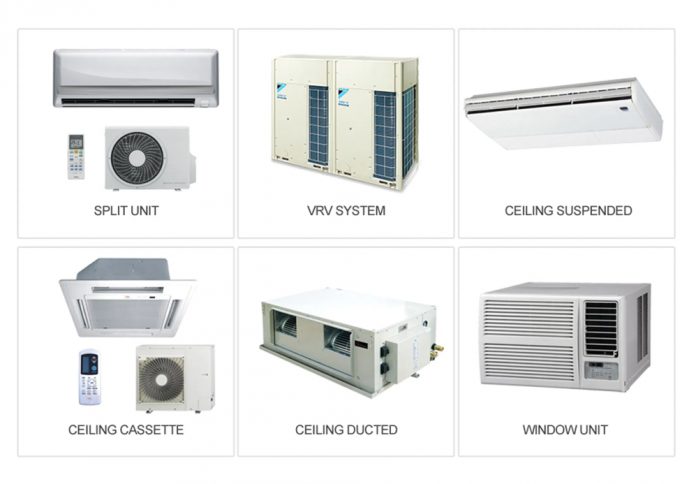Types of Air Conditioning Plants
- Centralized air – conditioning System
Unit air Conditioners
- Window type units
- Split-type units
Centralized Air Conditioning Plant
The central air conditioning plants or the systems are used when large buildings, hotels, theaters, airports, shopping malls, etc. are to be air-conditioned completely.
The air conditioning system operates essentially in a closed cycle.
Return air from different spaces in the property such as lodging rooms, dining areas, stores, banquet halls, kitchen, etc. comes back through the return duct is drawn by what is known as an extraction fan or exhauster.
This return air although a little stale is still cold/hot and relatively free from dirt and other contaminants present in the fresh air.
Instead of exhausting the entire return gas out and sucking in fresh air only, it is returned to the circuit to minimize energy requirement for cooling/heating and filtration.

Components of Centralised Air Conditioning Plant
- FRESH AIR INLET – It admits fresh air through a louver/grille situated on an outside wall very much away from the kitchen, boiler house, and water closet (WC) outlets.
- FILTERS – It is employed to arrest suspended particulate matter such as dirt and dust from inlet air.
- AIR WASHERS – This is the air – conditioning section which comprises of the pre-heater coil, refrigerating coil and banks of water sprays. The functions of air washers are to control humidity and clean air.
- SCRUBBER PLATES – These are a series of zigzag plates with a stream of water running down them and are used to catch the dirt-laden water droplets coming out from the water spray section in the air washer.
- WATER ELIMINATOR PLATES – These are a series of dry zigzag plates to remove any remaining free moisture in the air stream.
- MIST ELIMINATOR – It is a metallic / non-metallic bed through which air is flown upwards. Fine mist is trapped in the bed and fall down as they coalesce (combine) to bigger size.
- AIR HEATER – This is composed of heating coils to bring the air up to the desirable room temperature, if necessary.
- INLET FAN – It is a fan for drawing air through the inlet, ducting and forcing it into the various spaces in the building.
- FRESH AIR INLET/LOUVERS – They are fitted in the inlet of the fresh air for uniform entry of fresh air and hence smooth mixing with return air before entry to the air – conditioning section.
- ROOM INLET GRILLES – One or more grilles in each room for the controlled inflow of air.
- ROOM EXTRACTION GRILLES – One or more grilles in each room for the outflow of air. One to discharge outside into the atmosphere and another leading back to the AC plant inlet for the re-circulation.
- EXTRACTION FAN – It is the fan for extracting air in the return path of the air ducting coming back from rooms and spaces.
- CENTRAL EXTRACTION DAMPER – In case where complete central control is exercised a part of the return air from all spaces is discharged to the atmosphere through a control damper valve in the delivery side of the extractor fan.
- DUCTING – Ducting is a term used to denote the passage for the flow of air from the AC plant through various passages in the building opening into the closed space to be cooled and return to the inlet ducting in the AC plant. This also includes the ducting for the exhaust to the atmosphere.
Unit Air Conditioners – Window Type AC
- This is a completely self-contained unit with the compressor, condenser, evaporator, refrigerant piping, and air filter all assembled in a very compact manner.
- The window AC is usually 0.5 to 5 tons incapacity.
- The latest practice is to use sealed type compressor units so that the possibility of leakage of refrigerant is eliminated.
- There is a provision to control the fresh air intake.
- It is easy to install, operate and maintain.
- Its running cost is high.
- It requires at least one wall of the room free and open to atmosphere so that the air is discharged in the open.
Unit Air Conditioners –Split Type AC
In this system, the cold side of the unit ( such as expansion valve, evaporator coil) is physically separated from the hot side (compressor, condenser).
The refrigerant flows through a long pipeline connecting the hot side and the cold side.
The cold part inside the room and the hot part outside the building.
The main advantages of split type air conditioners are:
Low cost for relatively larger size units
Absence of noise as the compressor is placed outside the building.





best online pharmacies in mexico: Mexican Pharmacy Online – mexican border pharmacies shipping to usa
indian pharmacy https://indiaph24.store/# buy medicines online in india
indian pharmacy
http://mexicoph24.life/# best online pharmacies in mexico
canadian pharmacies [url=https://canadaph24.pro/#]legit canadian online pharmacy[/url] safe canadian pharmacies
medicine in mexico pharmacies: Mexican Pharmacy Online – buying prescription drugs in mexico
https://indiaph24.store/# legitimate online pharmacies india
https://ciprofloxacin.tech/# where can i buy cipro online
buy tamoxifen [url=https://nolvadex.life/#]low dose tamoxifen[/url] tamoxifen hot flashes
https://nolvadex.life/# tamoxifen therapy
buy cytotec in usa [url=https://cytotec.club/#]buy cytotec in usa[/url] cytotec online
tamoxifen hip pain: tamoxifen alternatives premenopausal – tamoxifen breast cancer prevention
https://finasteride.store/# buy propecia no prescription